load capacity CHRYSLER 300 2020 Vehicle Warranty
[x] Cancel search | Manufacturer: CHRYSLER, Model Year: 2020, Model line: 300, Model: CHRYSLER 300 2020Pages: 270, PDF Size: 3.86 MB
Page 213 of 270
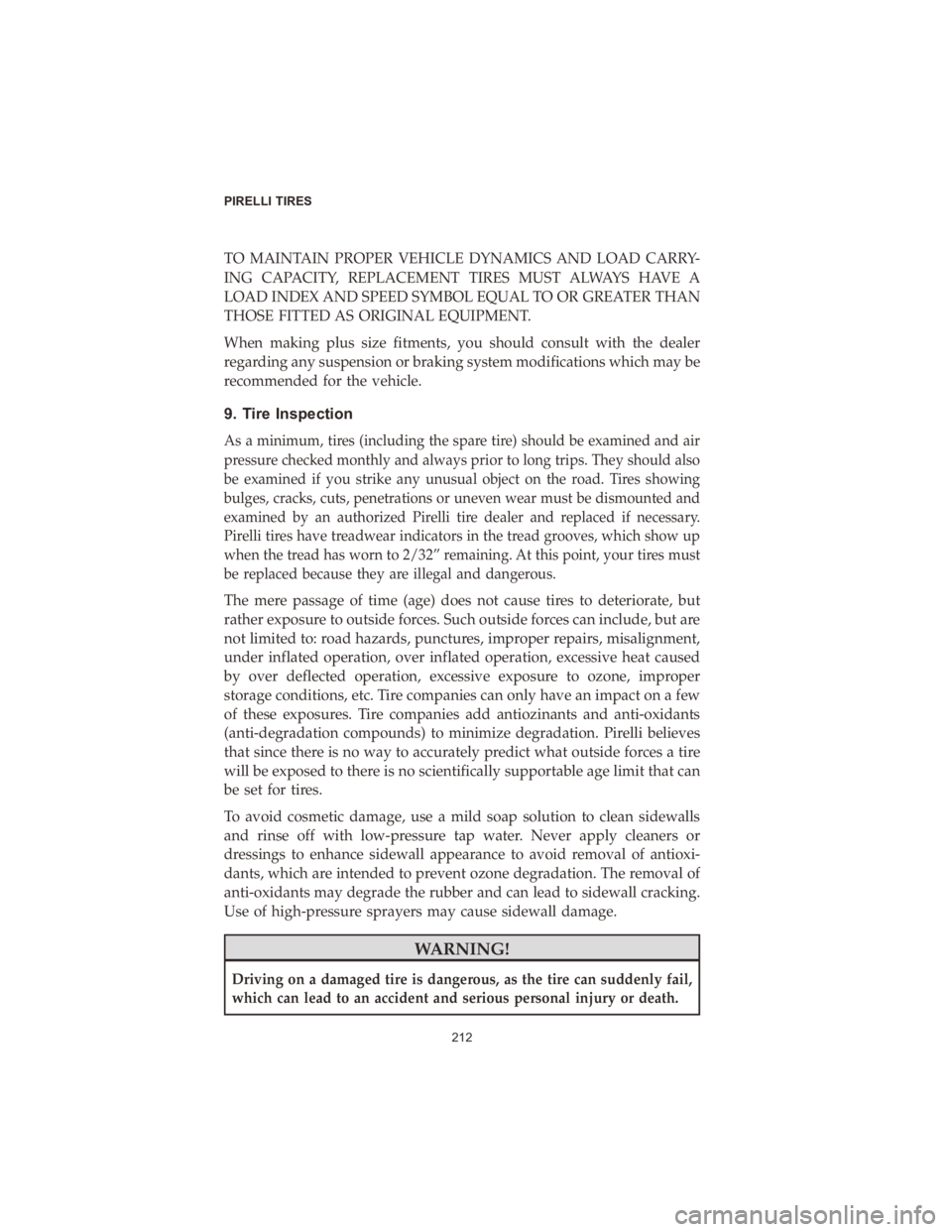
TO MAINTAIN PROPER VEHICLE DYNAMICS AND LOAD CARRY-
ING CAPACITY, REPLACEMENT TIRES MUST ALWAYS HAVE A
LOAD INDEX AND SPEED SYMBOL EQUAL TO OR GREATER THAN
THOSE FITTED AS ORIGINAL EQUIPMENT.
When making plus size fitments, you should consult with the dealer
regarding any suspension or braking system modifications which may be
recommended for the vehicle.
9. Tire Inspection
As a minimum, tires (including the spare tire) should be examined and air
pressure checked monthly and always prior to long trips. They should also
be examined if you strike any unusual object on the road. Tires showing
bulges, cracks, cuts, penetrations or uneven wear must be dismounted and
examined by an authorized Pirelli tire dealer and replaced if necessary.
Pirelli tires have treadwear indicators in the tread grooves, which show up
when the tread has worn to 2/32” remaining. At this point, your tires must
be replaced because they are illegal and dangerous.
The mere passage of time (age) does not cause tires to deteriorate, but
rather exposure to outside forces. Such outside forces can include, but are
not limited to: road hazards, punctures, improper repairs, misalignment,
under inflated operation, over inflated operation, excessive heat caused
by over deflected operation, excessive exposure to ozone, improper
storage conditions, etc. Tire companies can only have an impact on a few
of these exposures. Tire companies add antiozinants and anti-oxidants
(anti-degradation compounds) to minimize degradation. Pirelli believes
that since there is no way to accurately predict what outside forces a tire
will be exposed to there is no scientifically supportable age limit that can
be set for tires.
To avoid cosmetic damage, use a mild soap solution to clean sidewalls
and rinse off with low-pressure tap water. Never apply cleaners or
dressings to enhance sidewall appearance to avoid removal of antioxi-
dants, which are intended to prevent ozone degradation. The removal of
anti-oxidants may degrade the rubber and can lead to sidewall cracking.
Use of high-pressure sprayers may cause sidewall damage.
WARNING!
Driving on a damaged tire is dangerous, as the tire can suddenly fail,
which can lead to an accident and serious personal injury or death.
PIRELLI TIRES212
Page 234 of 270
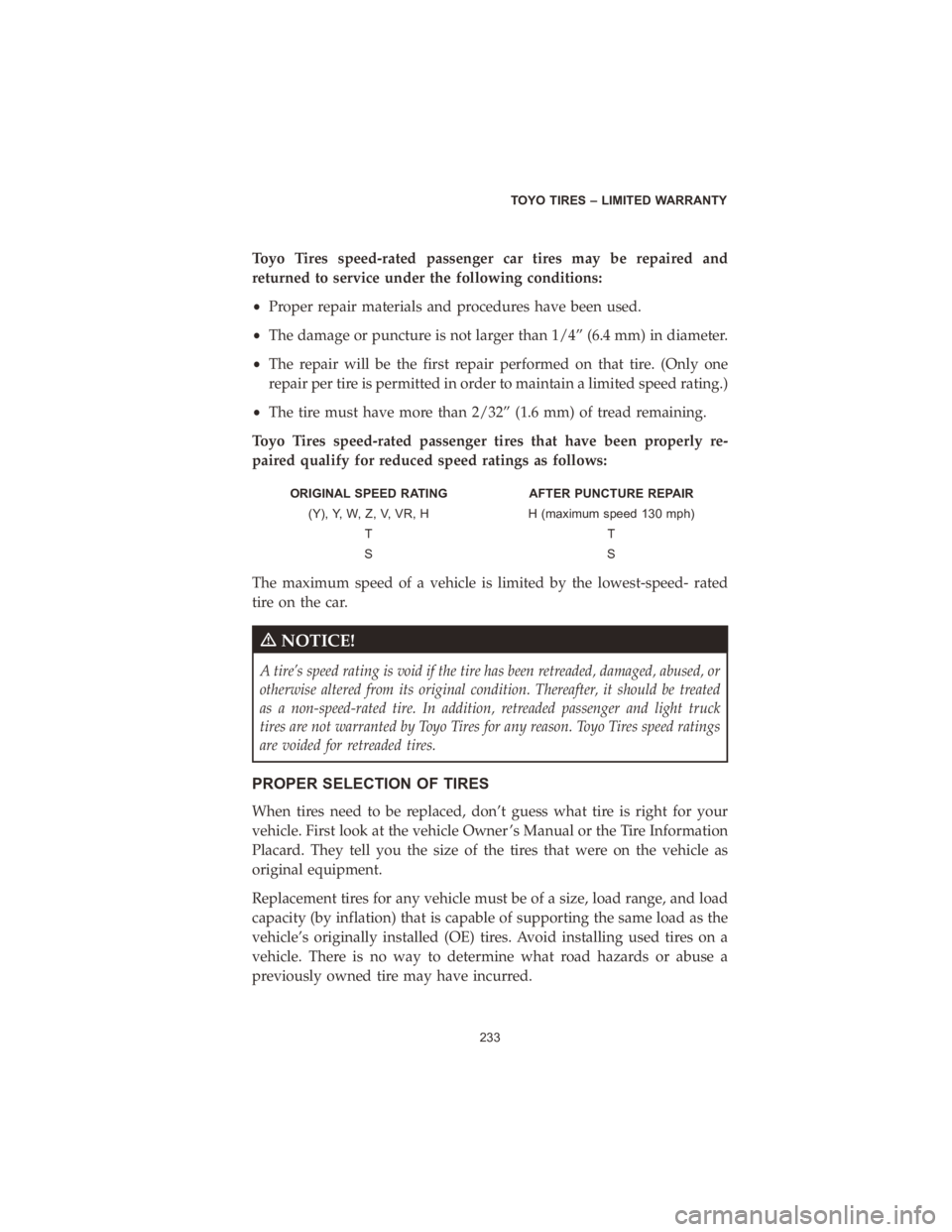
Toyo Tires speed-rated passenger car tires may be repaired and
returned to service under the following conditions:
•Proper repair materials and procedures have been used.
• The damage or puncture is not larger than 1/4” (6.4 mm) in diameter.
• The repair will be the first repair performed on that tire. (Only one
repair per tire is permitted in order to maintain a limited speed rating.)
• The tire must have more than 2/32” (1.6 mm) of tread remaining.
Toyo Tires speed-rated passenger tires that have been properly re-
paired qualify for reduced speed ratings as follows:
ORIGINAL SPEED RATING AFTER PUNCTURE REPAIR
(Y), Y, W, Z, V, VR, H H (maximum speed 130 mph)
TT
SS
The maximum speed of a vehicle is limited by the lowest-speed- rated
tire on the car.
m NOTICE!
A tire’s speed rating is void if the tire has been retreaded, damaged, abused, or
otherwise altered from its original condition. Thereafter, it should be treated
as a non-speed-rated tire. In addition, retreaded passenger and light truck
tires are not warranted by Toyo Tires for any reason. Toyo Tires speed ratings
are voided for retreaded tires.
PROPER SELECTION OF TIRES
When tires need to be replaced, don’t guess what tire is right for your
vehicle. First look at the vehicle Owner ’s Manual or the Tire Information
Placard. They tell you the size of the tires that were on the vehicle as
original equipment.
Replacement tires for any vehicle must be of a size, load range, and load
capacity (by inflation) that is capable of supporting the same load as the
vehicle’s originally installed (OE) tires. Avoid installing used tires on a
vehicle. There is no way to determine what road hazards or abuse a
previously owned tire may have incurred.
TOYO TIRES – LIMITED WARRANTY
233
Page 235 of 270
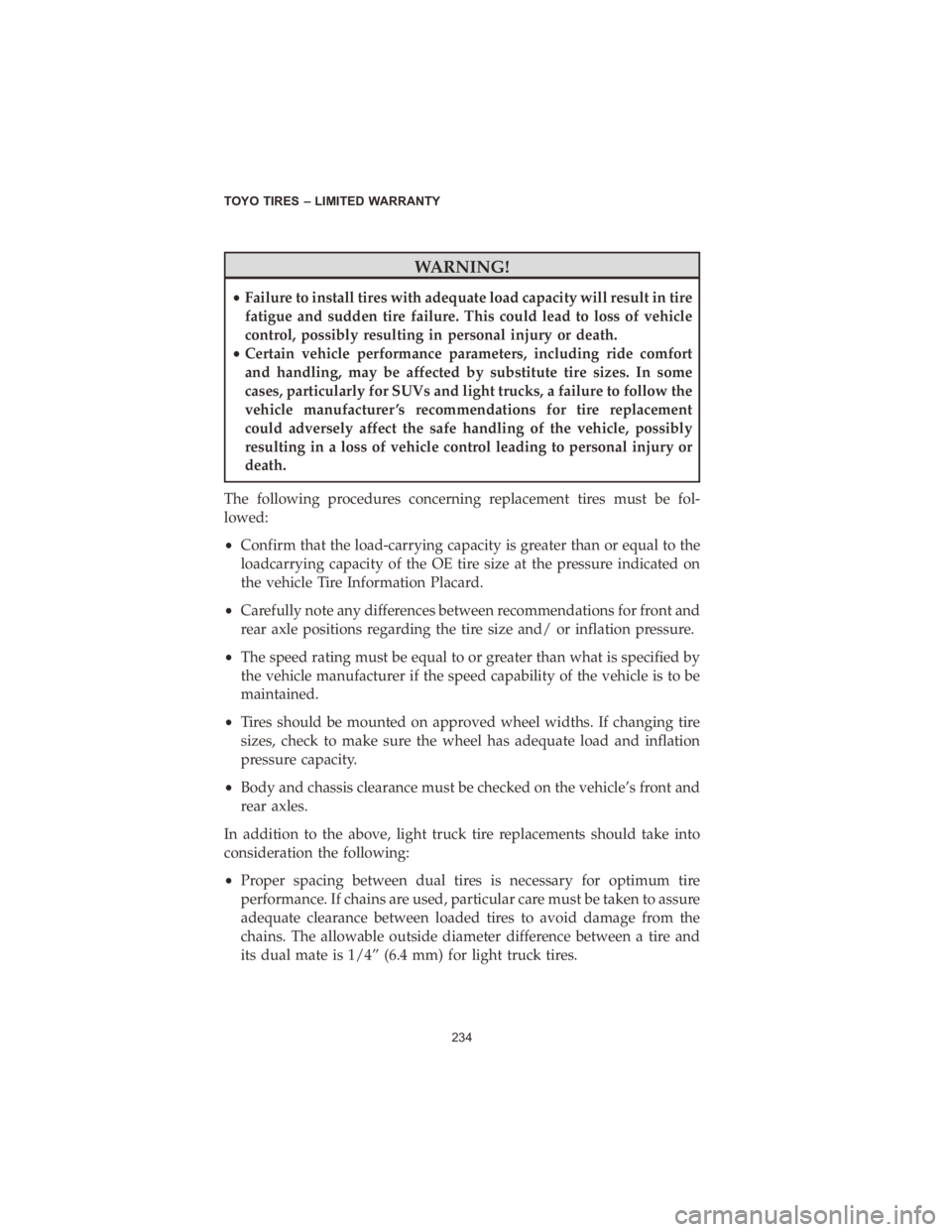
WARNING!
•Failure to install tires with adequate load capacity will result in tire
fatigue and sudden tire failure. This could lead to loss of vehicle
control, possibly resulting in personal injury or death.
• Certain vehicle performance parameters, including ride comfort
and handling, may be affected by substitute tire sizes. In some
cases, particularly for SUVs and light trucks, a failure to follow the
vehicle manufacturer ’s recommendations for tire replacement
could adversely affect the safe handling of the vehicle, possibly
resulting in a loss of vehicle control leading to personal injury or
death.
The following procedures concerning replacement tires must be fol-
lowed:
• Confirm that the load-carrying capacity is greater than or equal to the
loadcarrying capacity of the OE tire size at the pressure indicated on
the vehicle Tire Information Placard.
• Carefully note any differences between recommendations for front and
rear axle positions regarding the tire size and/ or inflation pressure.
• The speed rating must be equal to or greater than what is specified by
the vehicle manufacturer if the speed capability of the vehicle is to be
maintained.
• Tires should be mounted on approved wheel widths. If changing tire
sizes, check to make sure the wheel has adequate load and inflation
pressure capacity.
• Body and chassis clearance must be checked on the vehicle’s front and
rear axles.
In addition to the above, light truck tire replacements should take into
consideration the following:
• Proper spacing between dual tires is necessary for optimum tire
performance. If chains are used, particular care must be taken to assure
adequate clearance between loaded tires to avoid damage from the
chains. The allowable outside diameter difference between a tire and
its dual mate is 1/4” (6.4 mm) for light truck tires.
TOYO TIRES – LIMITED WARRANTY
234
Page 245 of 270
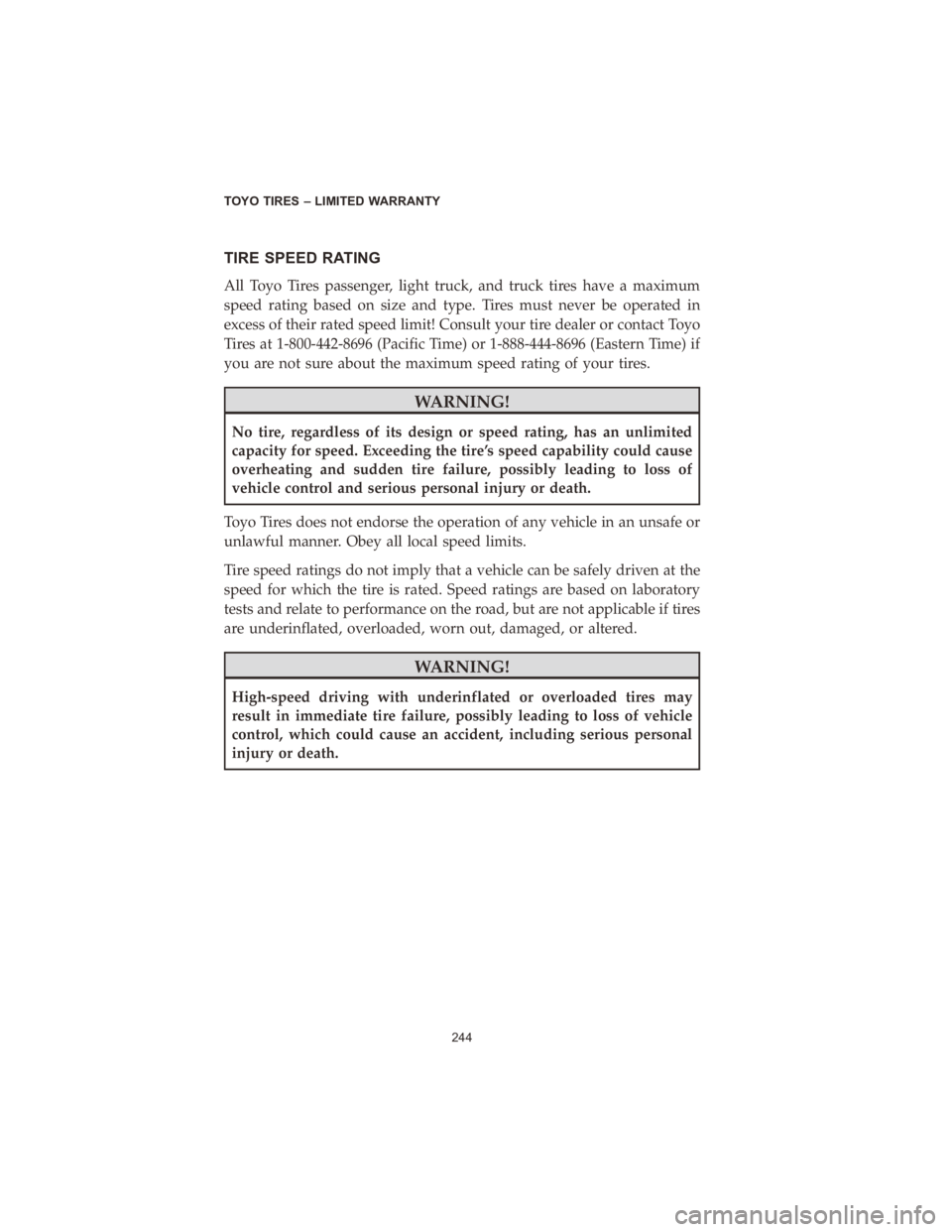
TIRE SPEED RATING
All Toyo Tires passenger, light truck, and truck tires have a maximum
speed rating based on size and type. Tires must never be operated in
excess of their rated speed limit! Consult your tire dealer or contact Toyo
Tires at 1-800-442-8696 (Pacific Time) or 1-888-444-8696 (Eastern Time) if
you are not sure about the maximum speed rating of your tires.
WARNING!
No tire, regardless of its design or speed rating, has an unlimited
capacity for speed. Exceeding the tire’s speed capability could cause
overheating and sudden tire failure, possibly leading to loss of
vehicle control and serious personal injury or death.
Toyo Tires does not endorse the operation of any vehicle in an unsafe or
unlawful manner. Obey all local speed limits.
Tire speed ratings do not imply that a vehicle can be safely driven at the
speed for which the tire is rated. Speed ratings are based on laboratory
tests and relate to performance on the road, but are not applicable if tires
are underinflated, overloaded, worn out, damaged, or altered.
WARNING!
High-speed driving with underinflated or overloaded tires may
result in immediate tire failure, possibly leading to loss of vehicle
control, which could cause an accident, including serious personal
injury or death.
TOYO TIRES – LIMITED WARRANTY
244
Page 253 of 270
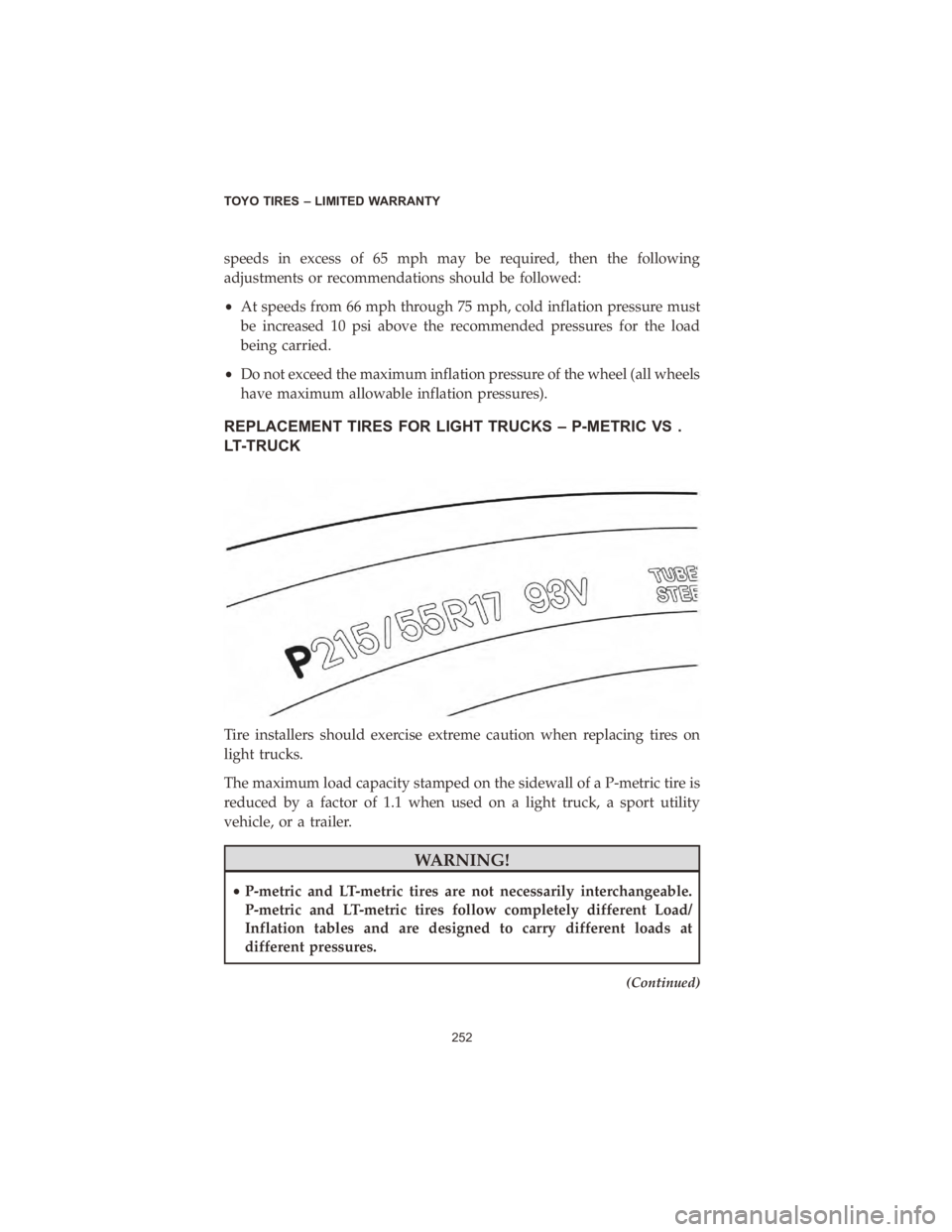
speeds in excess of 65 mph may be required, then the following
adjustments or recommendations should be followed:
•At speeds from 66 mph through 75 mph, cold inflation pressure must
be increased 10 psi above the recommended pressures for the load
being carried.
• Do not exceed the maximum inflation pressure of the wheel (all wheels
have maximum allowable inflation pressures).
REPLACEMENT TIRES FOR LIGHT TRUCKS – P-METRIC VS .
LT-TRUCK
Tire installers should exercise extreme caution when replacing tires on
light trucks.
The maximum load capacity stamped on the sidewall of a P-metric tire is
reduced by a factor of 1.1 when used on a light truck, a sport utility
vehicle, or a trailer.
WARNING!
•P-metric and LT-metric tires are not necessarily interchangeable.
P-metric and LT-metric tires follow completely different Load/
Inflation tables and are designed to carry different loads at
different pressures.
(Continued)
TOYO TIRES – LIMITED WARRANTY
252
Page 254 of 270
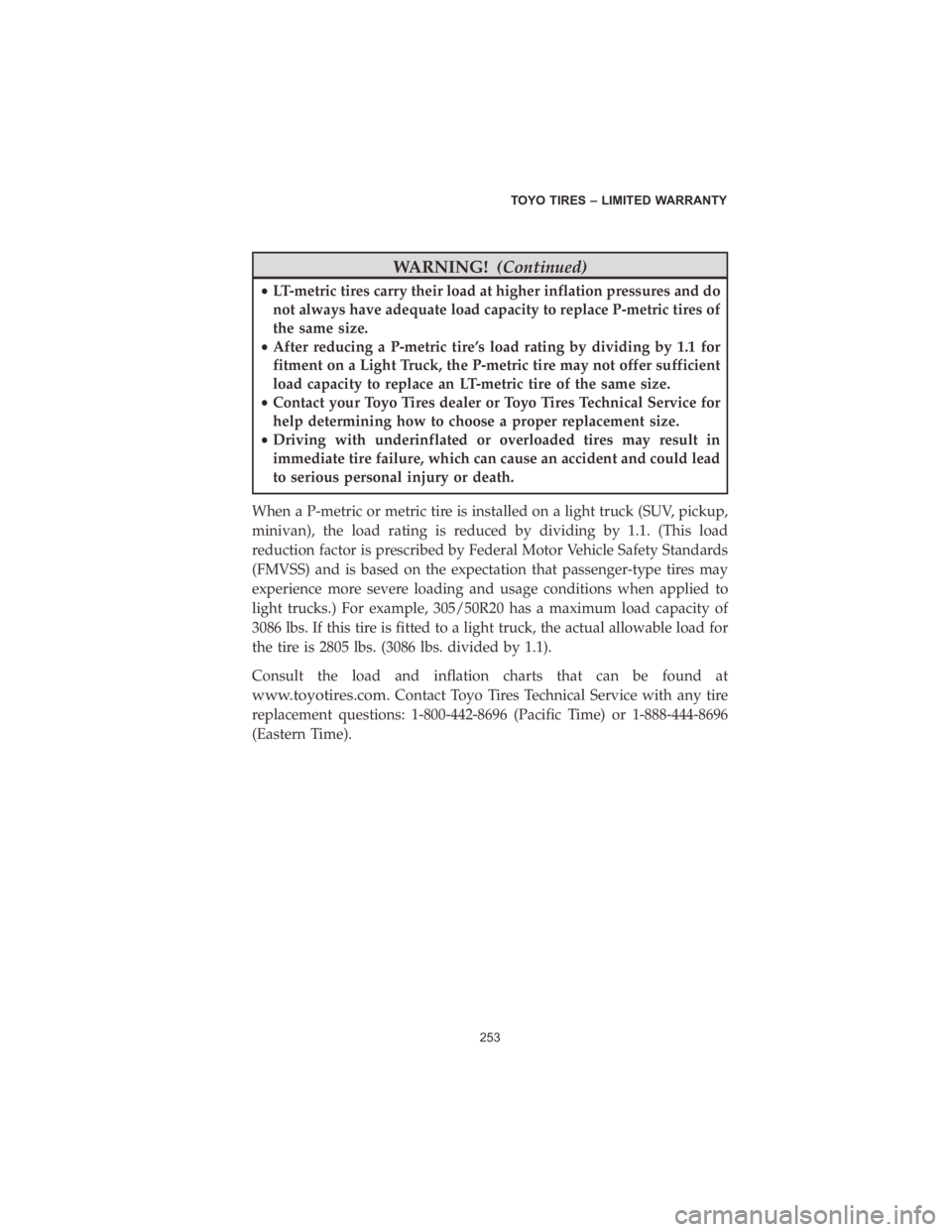
WARNING!(Continued)
•LT-metric tires carry their load at higher inflation pressures and do
not always have adequate load capacity to replace P-metric tires of
the same size.
• After reducing a P-metric tire’s load rating by dividing by 1.1 for
fitment on a Light Truck, the P-metric tire may not offer sufficient
load capacity to replace an LT-metric tire of the same size.
• Contact your Toyo Tires dealer or Toyo Tires Technical Service for
help determining how to choose a proper replacement size.
• Driving with underinflated or overloaded tires may result in
immediate tire failure, which can cause an accident and could lead
to serious personal injury or death.
When a P-metric or metric tire is installed on a light truck (SUV, pickup,
minivan), the load rating is reduced by dividing by 1.1. (This load
reduction factor is prescribed by Federal Motor Vehicle Safety Standards
(FMVSS) and is based on the expectation that passenger-type tires may
experience more severe loading and usage conditions when applied to
light trucks.) For example, 305/50R20 has a maximum load capacity of
3086 lbs. If this tire is fitted to a light truck, the actual allowable load for
the tire is 2805 lbs. (3086 lbs. divided by 1.1).
Consult the load and inflation charts that can be found at
www.toyotires.com. Contact Toyo Tires Technical Service with any tire
replacement questions: 1-800-442-8696 (Pacific Time) or 1-888-444-8696
(Eastern Time).
TOYO TIRES – LIMITED WARRANTY
253